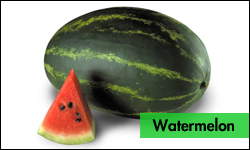Back to > Major Fruits | Minor Fruits | Underutilized Fruits
![]()
 |
||
|
|
||
Market and International Trade:
Domestic and Export Market Requirement:
The largest producer of cantaloupes and other melons worldwide in 2004 was China, accounting for over 50 percent of world production by weight, followed by Turkey with 6.1 percent, Iran was third with 4.4 percent, the U.S. fourth with 4.2 percent, and Spain fifth with 3.9 percent. Watermelons have accounted for roughly 50 percent of U.S. per capita melon consumption, cantaloupes 40 percent and honeydews about 10 percent. In 2004 watermelon consumption in US was 13 pounds per capita followed by cantaloupe consumption at 9.5 pounds and honeydew at 2.2 pounds. Consequently, US imported watermelon worth $100.6 million 91.2 % from Mexico, 3.5 % from Guatemala and 2.4 % from Costa Rica, respectively in 2004.
Market Price (referred to: http://faostat.fao.org/faostat/collections?subset=agriculture ):
Watermelon prices in US have varied mostly between $6 and $10 per cwt over the last decade, but peaked in 1980 at $12.19 per cwt. In 2004 the season-average price for watermelon was $7.87 per cwt. In 2006, the producer price for watermelon in US and Mexico were US109.2 /metric tonne and US180.78 per/ metric tonne, respectively.
Codex Alimentarius Commodities for which MRLs/EMRLs for watermelon can be found in CA-Code (VC-432).
Refer to UNECE STANDARD FFV-37 concerning the marketing and commercial quality control of watermelons. Refer to: (http://www.unece.org/trade/agr/standard/fresh/fresh_e/37watmel.pdf )
Watermelon Grader’s Guide explains the U.S. Standards for watermelon. This publication is intended to help producers and shippers grade and pack watermelon. By using this guide, producers will place on the market watermelon with acceptable quality standards. Refer to: (http://www.aces.edu/pubs/docs/A/ANR-0681/ )
COMMISSION REGULATION FOR WATERMELONS “COMMISSION REGULATION (EC) No 1862/2004 of 26 October 2004” lays down the marketing standard applicable to watermelons. Refer to: http://www.watermelonmessinias.gr/index.asp?section=category&cat=23&lang=en
Reference:
- “An African Native of World Popularity.” Texas A&M University Aggie Horticulture website. Retrieved Jul. 17, 2005.
- Anioleka Seeds USA. “Yellow Crimson Watermelon”. http://www.vegetableseed.net/heirloom-vegetable-seeds/melon-seeds/watermelon-seeds/yellow.html. Retrieved on 2007-08-07.
- Baker Creek Heirloom Seeds. “Watermelon Heirloom Seeds”. http://rareseeds.com/seeds/Watermelon. Retrieved on 2008-07-15.
- Baker Creek Heirloom Seeds. “Carolina Cross Watermelon”. http://rareseeds.com/seeds/Watermelon/Carolina-Cross. Retrieved on 2008-07-15.
- (BBC) Square fruit stuns Japanese shoppers BBC News Friday, 15 June, 2001, 10:54 GMT 11:54 UK
- “Black Japanese watermelon sold at record price“. http://ap.google.com/article/ALeqM5jJBRT0pnOdQVMUzzkKC_cGHo7IdQD914F62O0. Retrieved on 2008-06-10.
- Blomberg, Marina (June 10, 2004). “In Season: Savory Summer Fruits.” The Gainesville Sun. Retrieved Jul. 17, 2005.
- “Charles Fredric Andrus: Watermelon Breeder.” Cucurbit Breeding Horticultural Science. Retrieved Jul. 17, 2005.
- Collins JK, Wu G, Perkins-Veazie P, Spears K, Claypool PL, Baker RA, Clevidence BA. (2007). Watermelon consumption increases arginine plasma concentrations in adults. Nutrition 23(3):261-6.
- “Cream of Saskatchewan Watermelon“. http://www.seedsavers.org/prodinfo.asp?number=778. Retrieved on 2007-04-23.
- “Crop Production: Icebox Watermelons.” Washington State University Vancouver Research and Extension Unit website. Retrieved Jul. 17, 2005.
- Daniel Zohary and Maria Hopf, Domestication of Plants in the Old World, third edition (Oxford: University Press, 2000), p. 193.
- Dayer, R.D. (1975). The Genera of Southern African floweringbplants Vol. 1. Dicotyledons, Department of Agricultural Technical Services. South Africa: Botanical Research Institute.
- Evans, Lynette (2005-07-15). “Moon & Stars watermelon (Citrullus lanatus):Seed-spittin’ melons makin’ a comeback”. http://sfgate.com/cgi-bin/article.cgi?file=/chronicle/archive/2005/07/16/HOG4UDNGDB1.DTL. Retrieved on 2007-07-06.
- Hamish, Robertson. “Citrullus lanatus (Watermelon, Tsamma).” Museums Online South Africa. Retrieved Mar. 15, 2005.
- H. Mandel, N. Levy, S. Izkovitch, S. H. Korman (2005). “Elevated plasma citrulline and arginine due to consumption of Citrullus vulgaris (watermelon)”. Berichte der deutschen chemischen Gesellschaft 28 (4): 467–472. doi:10.1007/s10545-005-0467-1.
- “The column of watermelon peel from 5hpk.com”.
- http://www.5hpk.com/Html/TOPIC/200807172.html. Retrieved on 2008-07-15.
- http://www.agriculture.gov.gy/Farmers%20Manual/PDF/Watermelon.pdf. Retrieved on 2009-07-30
- Jian L, Lee AH, Binns CW. Tea and lycopene protect against prostate cancer. Asia Pac J Clin Nutr. 2007;16 Suppl 1:453-7. 2007. PMID:17392149.
- Lucotti P, Setola E, Monti LD, Galluccio E, Costa S, Sandoli EP, Fermo I, Rabaiotti G,Gatti R, Piatti P. (2006). Beneficial effects of a long-term oral L-arginine treatment added to a hypocaloric diet and exercise training program in obese, insulin-resistant type 2 diabetic patients. Am J Physiol Endocrinol Metab:291(5):E906-12.
- Matos HR, Di Mascio P, Medeiros MH. Protective effect of lycopene on lipid peroxidation and oxidative DNA damage in cell culture. Arch Biochem Biophys 2000 Nov 1;383(1):56-9 2000.
- “Melitopolski Watermelon“. http://www.seedsavers.org/prodinfo.asp?number=267. Retrieved on 2007-04-23.
- “Moon and Stars Watermelon Heirloom“. http://rareseeds.com/seeds/Watermelon/Moon-and-Stars. Retrieved on 2008-07-15.
- “Moon and Stars Watermelon“. http://www.seedsavers.org/prodinfo.asp?number=266. Retrieved on 2007-04-23.
- Motes, J.E.; Damicone, John; Roberts, Warren; Duthie, Jim; Edelson, Jonathan. “Watermelon Production.” Oklahoma Cooperative Extension Service. Retrieved Jul. 17, 2005.
- Müller T, Ulrich M, Ongania KH, Kräutler B. (2007). Colorless tetrapyrrolic chlorophyll catabolites found in ripening fruit are effective antioxidants. Angew Chem Int Ed Engl. 2007;46(45):8699-702.
- National Research Council (2008-01-25). “Watermelon”. Lost Crops of Africa: Volume III: Fruits. Lost Crops of Africa. 3. National Academies Press. ISBN 978-0-309-10596-5. http://books.nap.edu/openbook.php?record_id=11879&page=165. Retrieved on 2008-07-17.
- “Oklahoma Declares Watermelon Its State Vegetable“. 2007-04-18. http://cbs4denver.com/watercooler/watercooler_story_108064706.html. Retrieved on 2007-07-20.
- “Orangeglo Watermelon“. http://www.seedsavers.org/prodinfo.asp?number=1108. Retrieved on 2007-04-23.
- Parsons, Jerry, Ph.D. (June 5, 2002). “Gardening Column: Watermelons.” Texas Cooperative Extension of the Texas A&M University System. Jul. 17, 2005.
- Salleh, H. (1986). Constrain and challenges in melon breeding in Peninsular Malaysia. Proc. Of the Plant and Animal Breeding Workshop, Serdang: MARDI
- Shosteck, Robert (1974). Flowers and Plants: An International Lexicon with Biographical Notes. Quadrangle/The New York Times Book Co.: New York.
- Southern U.S. Cuisine: Judy’s Pickled Watermelon Rind
- http://home.howstuffworks.com/watermelon3.htm
- Stone, B.C. (1970). The flora of Guam. Micronesic 6: 562.
- Vegetable Research & Extension Center – Icebox Watermelons”. http://agsyst.wsu.edu/Watermelon.html. Retrieved on 2008-08-02.
- Wada, M. (1930). “Über Citrullin, eine neue Aminosäure im Presssaft der 28. Wassermelone, Citrullus vulgaris Schrad.”. Biochem. Zeit. 224: 420.
- “Watermelon.” The George Mateljan Foundation for The World’s Healthiest Foods. Retrieved Jul. 28, 2005.
- “Watermelon History.” National Watermelon Promotion Board website. Retrieved Jul. 17, 2005.
